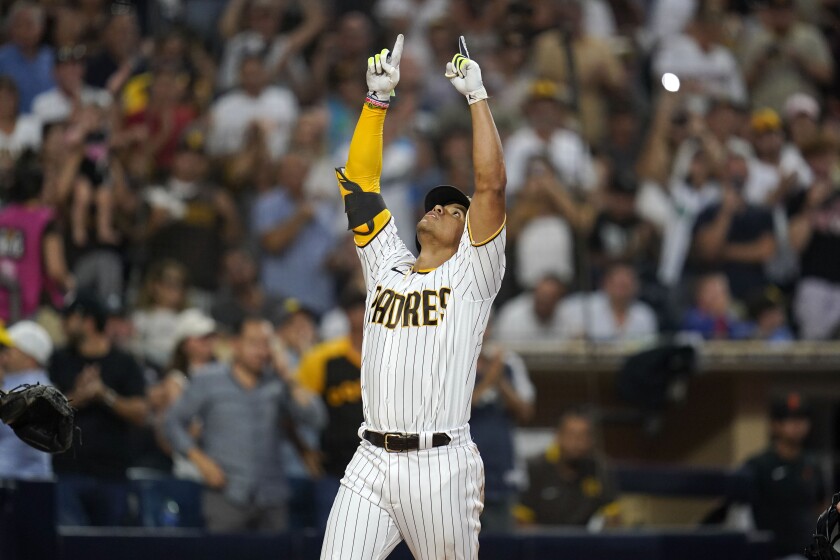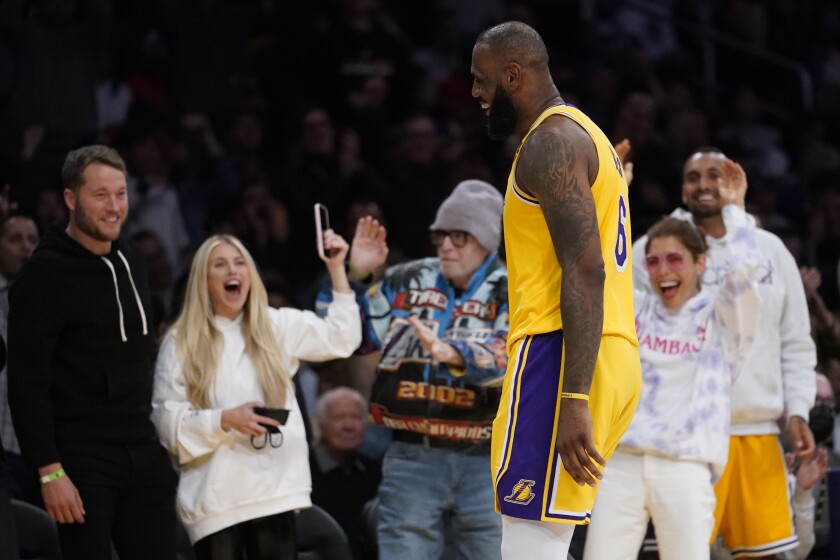No one listens to sports talk radio in LA Here’s why
The New England Patriots have not played a game in two months. The Boston Red Sox are locked out of spring training. The Celtics are in season, but 10 NBA teams have better records.
On the most popular show on the most popular sports radio station in America, there is plenty to talk about. It is cold and gray in Boston on this first Monday in March, but there is fire and fury on the air.
It is the day after Kyrie Irving, who defected from the Celtics in free agency three years ago after suggesting he wanted to stay, compared the relentlessly jeering Boston fans to a “scorned girlfriend.” The booing had been so harsh that Celtics star Jayson Tatum tried to hush the fans.
The Celtics won the game, mind you, but the afternoon hosts on WBZ-FM had Irving on their minds.
“How badly do you hate him out there — you, listening to me?” co-host Mike Felger asked. “And your best player loves him, defends him, likes him better than you.”
No city loves its sports talk like Boston, and no city tunes it out like Los Angeles, at least according to Nielsen ratings.
In May, for instance, WBZ was the top-ranked radio station in Boston, with sports-talk rival WEEI ranking 11th.
“When it comes to their teams, people here are insatiable,” said Felger’s co-host, Tony Massarotti.
In Los Angeles, KLAC ranked 23rd, tied with the classical music on KUSC. KSPN ranked 37th, just behind the Christian music on KFSH.
In each of the four quarters of 2021, the sports talk ratings were lower in Los Angeles than in any other top 10 market in the United States, according to research Nielsen compiled for The Times.
In the fall quarter of 2021, with the Dodgers in the playoffs and the Rams and Chargers heading there, LA sports talk stations combined to attract 3% of the total radio audience in the demographic most coveted by their potential advertisers: men aged 25-54 .
In San Francisco, New York, Chicago and Washington, that figure was at least 7%. In Atlanta, Dallas and Philadelphia, at least 10%. In Boston, 28%.
“How passionate are you?” asked WBZ program director Rick Radzik. “I think it’s the approach in the Northeast: it’s more fast-paced, aggressive, opinionated hosts than it is, ‘What do you think?’
“I don’t need to ask you. I’m going to tell you what I think and you can react to it, good or bad.”
Felger and Massarotti are former Boston Herald sportswriters, confident in the authority that comes from covering local teams for decades. Their rapport is evident, after 13 years together on air. They dispense hard-core analysis for diehard fans.
In their first segment that Monday, they took no calls. In the second, they took four calls within seven minutes: make your point, and be gone.
“People here are wacko about it,” Massarotti said. “They’re nut jobs. I say that with all the affection in my heart. They’re psycho about their teams. They’re crazy. That’s what we feed off.”
This is the fourth decade in which Steve Mason has been a fixture in Southern California sports radio, almost always teamed with John Ireland. The run was interrupted in the late 1990s, when Mason was on air in New York.
“There is a lot more anger, I think, in New York,” Mason said. “On the streets of New York, at the grocery store, at the Duane Reade (pharmacy), wherever you happen to be, you are always going to get anger in New York.
“It spills out into sports talk radio in a way that it certainly does not here.”
Ratings are fueled by more than rage. In Boston and Philadelphia, the top two markets in sports radio, the civic profiles are similar: what Massarotti called a “blue-collar” fan base built over generations, where everyone lives and breathes the same team in each sport.
In New York, allegiances are split between the Yankees and Mets, or the Giants and Jets. In Philadelphia, ride or die with the Phillies and the Eagles.
“Cold weather is part of it,” Massarotti said. “We’re just cooped up watching games sometimes.”
Jason Barrett, president of Barrett Sports Media, consults with broadcast executives on how to develop a successful sports radio station.
“It really is about understanding what local people value and care about, and delivering what they want,” he said.
“If you’re in the Northeast, you’re going to put a little more focus on phone calls, because people are a little more passionate, short fuses, and there is some entertainment value that comes through on the air. In other pockets of the country, people don’t get as worked up about stuff.”
“People here are wacko about it. … They’re psycho about their teams. They’re crazy. That’s what we feed off.”
— Boston sports radio host Tony Massarotti
Barrett formerly ran sports talk stations in Philadelphia, St. Louis and San Francisco.
“The Giants lost a game, and it’s the sixth day of April, and people aren’t ready to ride the pitcher out of town because he started off 0-2,” Barrett said. “In New York, they’re calling for his head.”
In markets where the fan base is rabid, team officials listen. They make regular sports radio appearances and, in the process, often make news. Jerry Jones, the Dallas Cowboys’ owner, holds court on air every week.
In advance of baseball’s trade deadline, the president of the Red Sox told radio listeners his team had not talked about a trade involving shortstop Xander Bogaerts or third baseman Rafael Devers, and indeed neither was traded. The general manager of the Washington Nationals told radio listeners his team would not rid itself of a contract albatross to lessen the return in a Juan Soto trade, and indeed the Nationals did not.

The San Diego Padres’ Juan Soto, who was acquired from the Washington Nationals at baseball’s trade deadline, has been a hot topic on sports talk radio in recent weeks.
(Gregory Bull / Associated Press)
Mellow listeners, pleasant weather and infrequent appearances by newsmakers need not doom a sports radio station. The ratings for sports radio are twice as high in San Francisco as they are in Los Angeles.
Barrett would be interested to see how much better the Los Angeles sports stations might perform if they switched to FM, with what he called “a real signal that could activate listeners.” All other things equal, he said, FM stations get better ratings. The Boston sports powerhouses are FM stations.
Barrett also cited the turnover among local sports shows, especially on KSPN.
“Radio is a relationship business,” he said. “Audiences have to build a routine with who they listen to. If you take people on and off every 6 to 12 to 18 months, it’s hard to get that consistency of listenership.”
On the Los Angeles sports stations, the morning shows are primarily national, where the host might talk about the Cowboys or Red Sox even if you want to talk about the Lakers or Dodgers.
“In most places, local always performs better,” Barrett said.
“The entertainment business is another sport here in LA”
— KSPN hosted Steve Mason
“We put on a national show from noon to 3 a couple years ago,” Mason said, “and it really, really hurt the station. We’ve adjusted to become more local.”
In a rage-free market, Mason said he believes he and Ireland have succeeded in their own way.
“We try to focus on the entertainment and the fun,” Mason said. “We don’t do politics. We don’t do anything that isn’t sports or isn’t fun.
“We actually steer clear of anger. We don’t do a caller-driven show. We may take two or three callers a show. We may take one guest a show, but not every day.”
Mason and Ireland do a sports show, but you might just as easily tune in and catch them talking about pop culture, television, or movies.
“The entertainment business,” Mason said, “is another sport here in LA”
Don Martin, who runs KLAC, has managed sports talk stations in Los Angeles for 20 years. You can ask him why sports radio does not work in this market, but he will tell you it does.
“Walk around this city,” he said. “Ask how many people know what station the Dodgers are on. It will blow your mind.”
That is awareness, not listenership. In the LA ratings, his station does not rank in the top 20.
“Here’s the number I look at: Where do we finish financially?” Martin said.
“That number you just quoted to me about how small it is? The people that use us to drive their product come here to do this, because it works. We don’t finish in the top 10 in billings, in the No. 1 billing market in the country, if it doesn’t work. Those advertisers don’t come back if it doesn’t work.”
Martin is as passionate as, if you will excuse me here, a caller to a Boston sports talk show.
“LA was a bad sports town for many, many years, if we want to call it like it is,” he said. “It wasn’t a sports town.
“It was a Dodgers and Lakers town. You couldn’t be a sports town, because everybody had their own football team, because we didn’t have one.”
Now? The Rams are back, and they just won the Super Bowl. The LA constellation includes LeBron James and Anthony Davis, Mookie Betts and Freddie Freeman, Matthew Stafford and Aaron Donald, Mike Trout and Shohei Ohtani, Kawhi Leonard and Paul George, Justin Herbert and Carlos Vela.

Lakers forward LeBron James smiles toward Rams quarterback Matthew Stafford and his wife, Kelly Stafford, during a game against the Golden State Warriors on March 5 at Crypto.com Arena.
(Ashley Landis / Associated Press)
NASCAR races in the Coliseum. The college football national championship will be here next year, and soon the World Cup and the Olympic Games.
“We have the greatest future in sports of any city in America,” Martin said.
Go on.
“Sports is the epicenter of what’s pulling this country together,” he said. “You’ve got 10% inflation. You’ve got a war going on. You’ve got gas prices of $7 a gallon. There’s death and mayhem all around you. We’re the escape.”
In LA, no one is choosing that escape route, at least by what the ratings say. Martin isn’t buying.
In the broadcast industry, Nielsen has been criticized for its slow transformation in measuring audiences from an era where everyone watched television in their living room at an appointed hour to an era where people watch and listen when they want, wherever they are, and on whatever devices they use.
“Nielsen’s measurement is a big issue in sports radio,” Barrett said, “and radio in general.”
Martin no longer cares for the word “radio.” He prefers “sports audio,” in a market where the combination of car culture and modern technology makes his audience increasing mobile.
His audience, as he counts it, might listen live, on the radio or via streaming. His audience might listen on demand, or on a separate podcast, or at a live event. His audience might interact with the station through social media.
In one day, Mason said, KSPN sold out of tickets to an awards show. Martin said 50,000 people might download a replay of a live event with Petros Papadakis and Matt “Money” Smith.
In one month, Martin said, 23 million people downloaded podcasts with KLAC’s nationally syndicated morning host, Colin Cowherd.
“One day, when we can put all that together, it will all speak for itself,” Martin said. “We will make all the ratings say what the ratings need to say.”